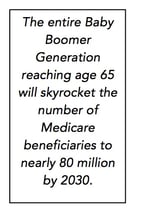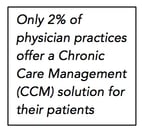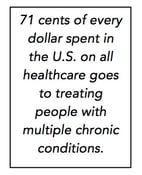
In the U.S. today, one in four Americans has multiple coexisting chronic conditions. That number rises to three in four Americans at age 65 and older1, or approximately 36 million Medicare eligible patients4, potentially creating a state of multimorbidity6- the co-occurrence of multiple chronic or acute diseases and medical conditions - within one person. The impact of these conditions can go beyond the patient as family members step in to help with even the most basic activities such as bathing, getting dressed or preparing a simple meal. Many times, it can be a challenge to know what’s best for the patient without a plan and direction on how to manage complex medication schedules, doctor visits and the overall burden of the co-occurring conditions.
 The “Silver Tsunami”- the entire Baby Boomer Generation reaching age 65 – will skyrocket the number of Medicare beneficiaries to nearly 80 million by 20302. The problem is further multiplied by people living longer, making the demand for services exponentially higher every year relative to previous generations. Conversely, the United States will face a workforce shortage of more than 100,000 physicians –both primary care and specialties such as emergency medicine, anesthesiology, radiology, neurology, and psychiatry during that same period5. The convergence of more patients and less doctors could cause a blight in care if the healthcare system continues to focus on the disease and not the patient. Without some change in the way we care for our aging population, helping those in need to effectively manage their chronic conditions to reach at least a minimum acceptable level daily function and health-related quality of life will continue to become an even greater challenge as less physicians try to treat more patients.
The “Silver Tsunami”- the entire Baby Boomer Generation reaching age 65 – will skyrocket the number of Medicare beneficiaries to nearly 80 million by 20302. The problem is further multiplied by people living longer, making the demand for services exponentially higher every year relative to previous generations. Conversely, the United States will face a workforce shortage of more than 100,000 physicians –both primary care and specialties such as emergency medicine, anesthesiology, radiology, neurology, and psychiatry during that same period5. The convergence of more patients and less doctors could cause a blight in care if the healthcare system continues to focus on the disease and not the patient. Without some change in the way we care for our aging population, helping those in need to effectively manage their chronic conditions to reach at least a minimum acceptable level daily function and health-related quality of life will continue to become an even greater challenge as less physicians try to treat more patients.
Currently, only 2% of physician practices offer a Chronic Care Management (CCM) solution for their patients. If there are payment incentives available and people in need of help, why are these services so scarce?
What exactly is Chronic Care Management?
 Let’s start out with understanding what defines Chronic Care Management (CCM). According to the Centers for Medicare & Medicaid Services (CMS), Chronic Care Management is a defined set of services performed by a physician or non- physician practitioner (Physician Assistant, Nurse Practitioner, Clinical Nurse Specialist, Certified Nurse-Midwife) and their clinical staff, by calendar month, for patients with two or more chronic conditions. The chronic conditions are expected to last at least 12 months or until the death of the patient, and place the patient at significant risk of death, acute exacerbation/decompensation, or functional decline. These conditions include, but are not limited to:
Let’s start out with understanding what defines Chronic Care Management (CCM). According to the Centers for Medicare & Medicaid Services (CMS), Chronic Care Management is a defined set of services performed by a physician or non- physician practitioner (Physician Assistant, Nurse Practitioner, Clinical Nurse Specialist, Certified Nurse-Midwife) and their clinical staff, by calendar month, for patients with two or more chronic conditions. The chronic conditions are expected to last at least 12 months or until the death of the patient, and place the patient at significant risk of death, acute exacerbation/decompensation, or functional decline. These conditions include, but are not limited to:
- Alzheimer’s disease and related dementia
- Arthritis (osteoarthritis and rheumatoid)
- Asthma
- Atrial fibrillation
- Autism spectrum disorders
- Cancer
- Cardiovascular Disease
- Chronic Obstructive Pulmonary Disease
- Depression
- Diabetes
- Hypertension
- Infectious diseases such as HIV/AIDS
Services offered within CCM include establishing and implementing a comprehensive care plan (G0506), 20 minutes of revising or monitoring the existing plan (CPT 99490), or more complex chronic care management services that include establishment or substantial revision of the care plan, moderate or high complexity medical decision making regarding patient care and 60 minutes of clinical staff time directed by a physician or other qualified health care professional, per calendar month (CPT 99487). Should additional time be required by a primary procedure, and additional code (CPT 99489) is available for an additional 30 minutes of clinical staff time directed by a physician or other qualified health care professional, per calendar month.
The Cost of Managing Multiple Chronic Conditions
 Many of the common conditions identified are costly and depend on a high volume of care by themselves, but when combined in a patient of advanced age, the resources required are significant. 71 cents of every dollar spent in the U.S. on all healthcare goes to treating people with multiple chronic conditions. The problem is even more costly when considering only Medicare spend. 93 cents of every dollar of Medicare expenditure goes to treating people with multiple chronic conditions, or multimorbidity. Out-of-pocket costs can exceed $1,600 for prescriptions, co-pays and other items required for facilitating care, creating an immediate hardship for those with limited incomes and potentially catastrophic if depending only on Social Security benefits.
Many of the common conditions identified are costly and depend on a high volume of care by themselves, but when combined in a patient of advanced age, the resources required are significant. 71 cents of every dollar spent in the U.S. on all healthcare goes to treating people with multiple chronic conditions. The problem is even more costly when considering only Medicare spend. 93 cents of every dollar of Medicare expenditure goes to treating people with multiple chronic conditions, or multimorbidity. Out-of-pocket costs can exceed $1,600 for prescriptions, co-pays and other items required for facilitating care, creating an immediate hardship for those with limited incomes and potentially catastrophic if depending only on Social Security benefits.
There is an Answer
Currently, only 2% of physician practices offer a Chronic Care Management (CCM) solution for their patients. If there are payment incentives available and people in need of help, why are these services so scarce? When CMS initially launched the program in January 2015, providers were only given a few months to take advantage of the new 99490 code without any clarity on the potential of the new code2. Those that eventually did implement a chronic care management program, found that garnering an ROI on the program difficult as it typically required additional staff and treatment areas that outspent the billing.
Partnering with a vendor who can provide an intelligent and collaborative care solution that transforms the usual Chronic Care Management workflow is now an option for most practices. Enabling providers through near premise clinical staff pods and a modular platform built to adapt to public policy changes, new code opportunities and constantly evolving proprietary outcomes-based care pathways is the way to transform patient outcomes and maximize reimbursement in a CCM program. Best of all, implementing such a solution extends a practice without additional overhead, does not impose on your current clinical or billing staff, and is a simple addition to an existing workflow. Need more proof for way you need to be ready to help those in need as the Silver Tsunami draws near? Check out our infographic, “How Much Money are You Leaving on the Table by Not Offering CCM Services?” .
- https://www.cdc.gov/chronicdisease/about/multiple-chronic.htm
- http://www.healthcareitnews.com/news/chronic-care-management-50-billion-market-more-hype-reality
- https://www.cms.gov/Outreach-and-Education/Outreach/NPC/Downloads/2017-02-21-CCM-Presentation.pdf
- census.gov
- https://news.aamc.org/medical-education/article/new-aamc-research-reaffirms-looming-physician-shor/
- https://www.ncbi.nlm.nih.gov/pmc/articles/PMC2713155/



